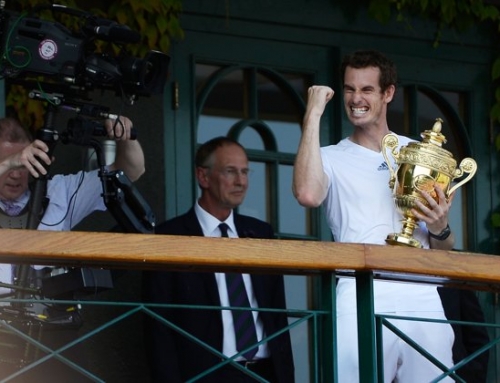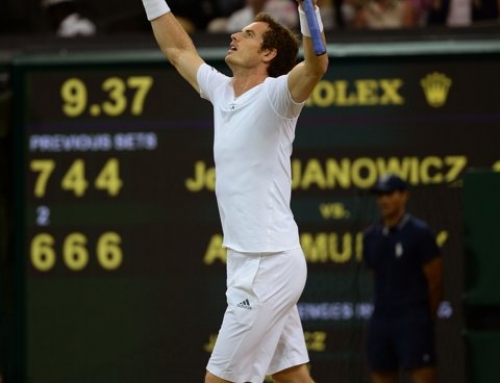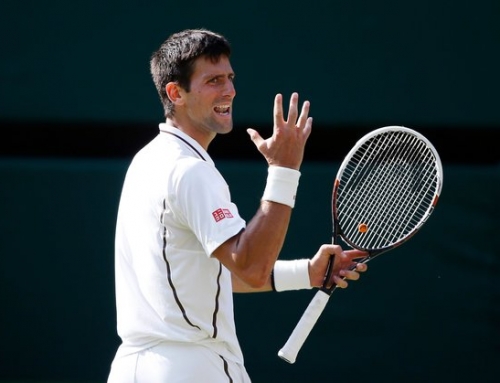 Between the two of them, they served 46 aces. Ivo Karlovic serves that many on a good day. Andy Murray with 25. Andy Roddick with 21.
Between the two of them, they served 46 aces. Ivo Karlovic serves that many on a good day. Andy Murray with 25. Andy Roddick with 21.
It was billed as the battle of the two Andy’s. On the one side was Andy Roddick. His career had been a merry-go-round of coaches. He had worked with Brad Gilbert, Jimmy Connors, Patrick McEnroe, and even his own brother, before working with Larry Stefanki who had worked with the likes of Fernando Gonzalez and Marcelo Rios.
Andy Roddick has been the tour’s pretty boy. His huge serves lead to big sales for Babolat when they needed a big name to propel the racquet. Back then, Roddick was the big serve and the big forehand. He won the US Open back in 2003 in straight sets over Spaniard, Juan Carlos Ferrero. He spent 13 weeks as number 1. He was one of several that took the mantle during the tumultuous period between the fading days of Sampras and the ascendancy of Roger Federer.
His big game lead him to three more finals. Once in 2004 Wimbledon, then once again in 2005 Wimbledon, and finally once again in 2006 US Open. Yet each time he was thwarted by the same man. If Federer’s nemesis was one Rafael Nadal, then Andy Roddick’s was one Roger Federer. The Swiss maestro with his dizzying array of shots.
Even has his star faded, Roddick fought. In 2008, things started off well. He had beaten Nadal and Djokovic to win in Dubai. Later in the summer, he reached the semifinals at Rome, but had to retire against Wawrinka due to back injuries. He would skip the French. He would lose to Tipsarevic in the 2nd round at Wimbledon, then he skipped the Olympics, and lost to del Potro and lost to Troicki, all under the tutelage of his brother. His game was floundering, and he sought help from Patrick McEnroe. Under his guidance, he got to the quarterfinals of the US Open where he would lose to Novak Djokovic, where Djokovic would infamously criticize Roddick for claiming Djokovic had faked his injuries. This would lead to boos and a falling out of Djokovic’s popularity.
Roddick would seek help from Larry Stefanki who immediately told him he needed to lose 15 lbs and work on his fitness.
On the other side was Andy Murray. Murray’s 2008 was as bright as Roddick’s had dimmed. Murray had started the year at number 6. He had separated from his coach, Brad Gilbert. He felt he argued too much with Gilbert and needed a team around him that he would feel comfortable with. That team included several people, most notably his coach, Miles Maclagan.
Key to the new Murray was a year-round effort for fitness. A fitness coach would travel with him year round. Although Murray started off 2008 strong, it soon faded some, as he adjusted to his new routine. He had a poor clay court season. Wimbledon marked a turnaround. In the 4th round, down two sets to love to Frenchman, Richard Gasquet, Murray came back to win in five sets. He would go out in straights to the ever-improving Rafael Nadal who would go on to claim his first Wimbledon title.
Murray used this victory to buoy him to a successful hardcourt season which resulted in two victories over then number 3 Novak Djokovic. Though he would be eliminated early in the Olympics, he came back strong in the US Open beating Rafael Nadal for the first time in four sets, though he faded to the Swiss superstar in straight sets in a Monday final that was delayed due to rain.
Murray would continue on to have a very solid beginning of the year. He would lose in the finals of Indian Wells on a blustery day to Rafael Nadal, but turn it around to beat Novak Djokovic in Miami, his home away from home.
When his ranked moved from 4 to 3, displacing Serbian, Novak Djokovic, Murray would be proclaimed as the heir apparent to Fred Perry, the next great British hope to win Wimbledon.
When he handily dismissed Juan Carlos Ferrero in the quarterfinals, the British public felt sure he could beat Andy Roddick. Murray had a 6-2 head-to-head, including a straight set drubbing back in 2006 at Wimbledon. He knew how to beat this guy.
But where Murray was basically an unknown in 2006, he was quite a well-known commodity in 2009.
When Roddick first worked with Stefanki, it was early on in 2009 and Roddick was facing Murray. Stefanki asked what Roddick planned to do, and he said he would try to out hit Murray. This failed miserably and Murray won in straight sets in Doha.
Roddick took a new approach. He would play patient. He would wait for his spots. He would come to net. This patience plus one of Murray’s poorer serving days lead to Roddick getting a break in the first set and winning it. Early in the second set, Murray would get a triple break point on Roddick’s serve. He would proceed to break and hold that one break lead and win the set.
Murray then opened the third set with another triple break point opportunity. This time, Roddick came back and won this early game. Not only that, he broke Murray and eventually raced to a 5-2 lead in the third set. Murray would hold, then, break, then hold again. Would Murray come back? The two went into a tiebreaker. Roddick had some insane tiebreak record in 2009 of 24-4. He would win the tiebreak 8-6, and try to close it out on the fourth set. This match would again go to a tiebreak, and this time, Andy Roddick would pull it out, and British hopes would be dashed for another year.
Roddick’s success came from a variety of strategies. One was an excellent service day. Roddick would serve at 75%, and at earlier points be closer to 80%. Murray, on the other hand, normally a better server than today, served a measly 52%. This, more than anything, made it tough for Murray. Roddick was eager to pounce on second serves. He also judiciously came to net, serving and volleying at times.
Roddick noted, after the match ended, that few had picked him to beat Murray given their recent record. Even Roddick seemed a bit surprised. He knows his record against Federer makes him a decided underdog. Beating Murray with a 6-2 losing record is one thing. Beating Federer, when he has a 18-2 record is another. Roddick may despair trying to beat Federer, but reaching the finals is something he thought was already passed him.
So another Wimbledon is drawing to a close, and Federer has to be thinking what unusual luck he has had. His biggest rivals, the ones that have given him the most trouble have faded. Nadal was in no shape to defend his title. Djokovic had too tough a time with Tommy Haas. Andy Murray bowed out to Andy Roddick.
Can Roddick finally turn it around? Maybe not. But few thought he was ready to take out Andy Murray. Few thought Andy Murray would wilt under the pressure of a demanding British public. In the end, though, one can say that Roger Federer is Roger Federer and not Andy Murray. This final may not match the one from last year, but Federer doesn’t particularly mind how he get his titles.
Andy Roddick may go as the least successful Grand Slam finalist ever. And he has one person to blame for it. In the meanwhile, he can savor the fact that the tournament started with 128 people, and for a day or so, he’s one of 2 remaining.







![[Wimbledon, QF] Murray scraps out 5-set win over Verdasco to reach semifinals](https://www.essentialtennis.com/wp-content/uploads/2013/07/20130703murray-500x383.jpg)